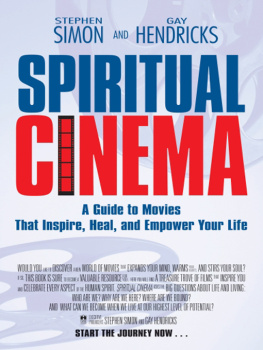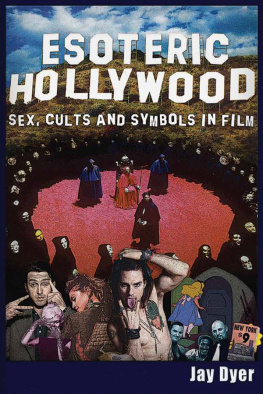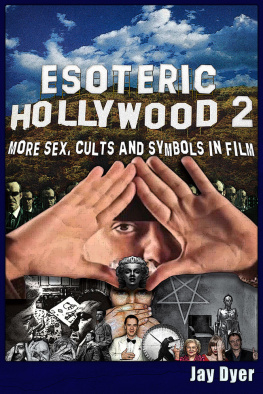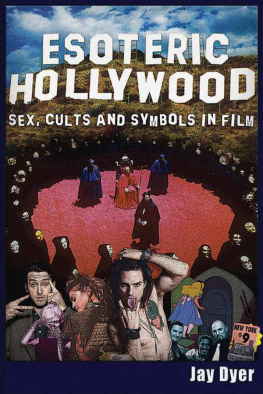
CINEMA SYMBOLISM:
A GUIDE TO ESOTERIC IMAGERY IN POPULAR MOVIES
BY ROBERT W.SULLIVAN IV. ESQ.
Cover: (Top Left) Scarecrow, Tin Man, Dorothy, & Lion from The Wizard of Oz; (Top Right) Boris Karloff as Frankensteins Monster; Center: Back to the Futures DeLorean; (Bottom Left) Yoda from The Empire Strikes Back; (Bottom Right) Fight Club promotional soap.
ISBN: 978-0-692-83611-8
ISBN: 978-0-692-86338-1 (e-book)
First Edition published 2014-2016.
Second Edition published by DEADWOOD PUBLISHING, LLC.,
2017.
All rights reserved.
Copyright November 2013 by Robert W. Sullivan IV, Esq.
Legal Disclaimer: All images which appear in Cinema Symbolism: A Guide to
Esoteric Imagery in Popular Movies, are either 1) in the Public Domain,
2) permitted by the Fair Use Doctrine (text is educational research), and
3)the Nominative Use Doctrine for any trademarks/logos. The author of this book does not maintain ownership over any of the images that appear as part of this book except the About the Author photo.
All text was copyrighted November 1, 2013, with the Copyright Office, Library of Congress.
This book is dedicated to movie fans everywhere.
CONTENTS
LIST OF ILLUSTRATIONS
Introduction:
Chapter I
Chapter II
Chapter III
Chapter IV
Chapter V
Chapter VI
Chapter VII
Chapter VIII
Chapter IX
Chapter X
Chapter XI
Chapter XII
Chapter XIII
About the Author
PREFACE
Thrill me. - Detective Ray Cameron, Night of the Creeps, 1986.
The analogy of opposites is the relation
of light to shadow, peak to abyss, fullness to void.
Allegory, mother of all dogmas, is the replacement
of the seal by the Hallmark, or reality by shadow;
it is the falsehood of truth, and the truth
of falsehood. - Eliphas Levi, Dogme de la Haute Magie,
Paris, Balliere, 1856, XXII, 22.
No doubt there are some among you
who will doubt the truth of what Im about to say
or doubt the reality of what you are about to see.
But believe me my friends, this is no fake.
Before your very eyes is all that remains of a vampire,
one of the worlds undead. Dare I but remove this stake
from where his heart once beat, and he would rise from the
grave within which he lies and turn into a bat,
a vampire bat whod feed hideously upon the living
whose veins pulsate with warm and vibrant blood.
Ladies and gentlemen, the actual skeleton of Count Dracula the Vampire!
- Dr. Gustav Niemann, House of Frankenstein, 1944.
You ever listen to K-Billys Super Sounds of the
Seventies? Its my personal favorite.
- Mr. Blonde, Reservoir Dogs, 1992.
Of course hes dead, the dosage was too large.
- Herbert West, Re-Animator, 1985.
I told you a long time ago you fucking little monkey not to fuck me!"
- Alejandro Sosa, Scarface, 1983.
Beware, beware. Beware of the big green dragon
that sits on your doorstep. He eats little boys. Puppy dog tails
and big fat snails. Beware, take care. Beware.
- Scientist, Glen or Glenda, 1953.
M ovies are the new mythology, they formulate modern legends that transcend material culture and the social fabric. Hollywoods influence is undeniable; visit any bar in America on a Friday night and one will eventually hear someone quoting Ben Obi-Wan Kenobi (Alec Guinness, 1914-2000) from Star Wars Episode IV: A New Hope (1977), Tony Montana (A1 Pacino) from Scarface (1983), or Mr. Pink (Steve Buscemi) from Reservoir Dogs (1992). Movies define us and in turn we glorify them or at least try to; in other words films are a reflection of both the conscious and the unconscious while society, in turn, often mimics them. This is best described by the phrase, life imitates art. Who has not heard the phrase, Heres looking at you kid, or May the Force be with you? Unless one has been living in a cave for the last sixty years the answer is no one. Nothing clean. Right. is idiosyncratically spoken by Arnold Schwarzenegger playing a time traveling Cyberdyne Systems Model 101 in The Terminator (1984). The Punk Leader (Bill Paxton) responds quipping, Hey I think this guys a couple cans short of a six-pack, while the Terminators line Ill be back, is his catch phrase that one immediately associates with the Austrian actor and former governor of California. Lest we forget the scene, when, Cyberdyne Systems Model 101 goes into a gunsmith seeking to acquire firearms of a highly sophisticated nature. Like a kid in a candy shop, the Terminator orders them like he was purchasing fast-food from McDonalds. He even asks for a weapon that has yet to be invented, a Phased Plasma Rifle in the 40 Watt Range to which the store owner replies, Hey, just what you see pal. Although it was a made-for-television horror film, everyone remembers Karen Black (1939-2013) as Amelia (Story III) who is chased, attacked, tormented, and ultimately possessed by a vicious Zuni fetish doll in 1975s Trilogy of Terror.
Some movies are so omnipresent that to not be familiar with them is a form of social ostracization. Films such as Scarface, The Godfather (1972), The Empire Strikes Back (1980), Casablanca (1942), Saturday Night Fever (1977), Reservoir Dogs (1992), The Exorcist (1973), Gone with the Wind (1939) and The Wizard of Oz (1939) are so ingrained on the psyche that there is not an adult American who is not familiar with them in some form or fashion. One could even argue that they are not even American anymore since they are so well known they belong to everyone in every nation. Unfamiliarity with certain films may transform a person into a social leper while, on the other end of the spectrum, some movies are so bad that they are actually good. This maxim applies to movies that aspire to be great but fail thus achieving what is commonly called cult status; when a film has a group of disciples that adore it regardless of its bizarre nature. Movies produced and directed by Edward D. Wood Jr. (1924-1978) would fall into this category. Alternatively, some movies were box offices failures yet now are received as cinematic classics; The Rocky Horror Picture Show (1975) is shown to sold out midnight audiences, while A Christmas Story (1983) now airs twenty-four hours around the clock starting on Christmas Eve on Turner Network Television or TNT. There is not a person out there who does not know the story of Ralphie (Peter Billingsley) and his desire to get a Red Ryder BB Gun for Christmas. Everyone knows that, when attending a midnight viewing of The Rocky Horror Picture Show, it is not enough to sit there and watch it rather one must experience it. The patrons will dress up as their favorite characters becoming Janet Weiss, a heroine (Susan Sarandon), Brad Majors, a hero (Barry Bostwick), Magenta, a domestic (Patricia Quinn), Columbia, a groupie (Little Nell) Riff Raff, a handyman (Richard OBrien) Dr. Frank-N-Furter, a scientist (Tim Curry) while singing-a-long to the films soundtrack.
This book was borne out of the last chapter of my first book, The Royal Arch of Enoch: The Impact of Masonic Ritual, Philosophy, and Symbolism which was published in August 2012. Chapter XV is titled, So Dark the Con of Man, exploring Masonic, solar, occult, and Enochian symbolism in modern cinema. Movies discussed and analyzed include 1979s
Next page






